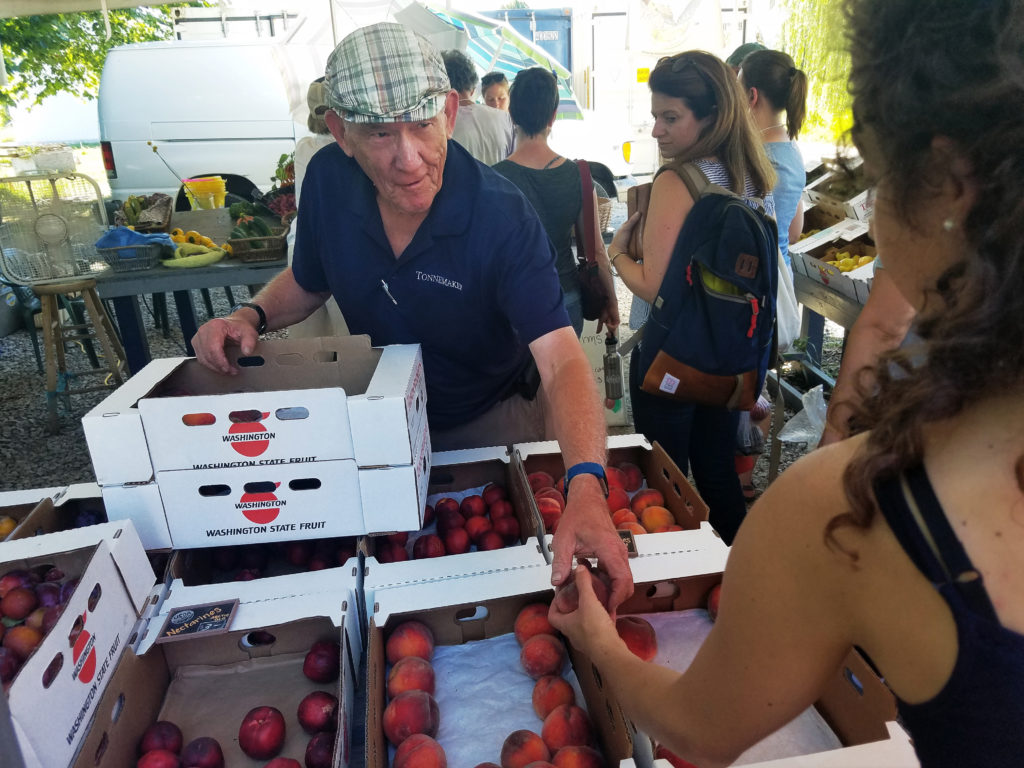
Editor’s Note: This is the first post in a multi-part blog series analyzing the final negotiated 2018 Farm Bill, which was released on December 11, 2018 by the leaders of the Farm Bill Conference Committee. Subsequent posts focus on: beginning and socially disadvantaged farmers and ranchers, organic agriculture, conservation, research and seed breeding, and crop insurance and commodity subsidies. The bill was passed by the Senate and House this week and sent to the President for his signature.
For increasingly more Americans, eating locally produced foods is becoming a priority. Family farmers are interested too, because local and regional marketplaces often offer better prices for farmers’ products, which helps them to sustain their businesses and put food on their families’ tables.
If consumers want local food and farmers want to grow it, why then does demand still far outstrip supply? The short answer is: connectivity. Farmers need both infrastructure and peer and professional networks in order to enter and succeed in new marketplaces, and for years the federal government has failed to adequately invest in farm-to-fork value chains. In the 2018 Farm Bill, however, family farmers and local food advocates can celebrate long-awaited investments in these growing food systems.
The 2018 Farm Bill Conference Report introduced this week by Senate Agriculture Committee Chairman Pat Roberts (R-KS), Ranking Member Debbie Stabenow (D-MI), House Agriculture Committee Chairman Mike Conaway (R-TX) and Ranking Member Colin Peterson (D-MN), connects the dots between farmers and new markets by investing in local and regional food systems. The bill also renews critical programs and investments in rural economic development.
The National Sustainable Agriculture Coalition (NSAC) was pleased to see that the Conference Report incorporated many of the provisions of the Local Food and Regional Market Supply (FARMS) Act, which was introduced in both the House and the Senate in 2017. NSAC has been a vocal champion of LAMP, as well as a strong supporter of the original marker bill that inspired it, the Local FARMS Act.
Below, we include a summary of the key takeaways on how the final conferenced bill approaches local and regional food system and rural development programs:
Highlights
- Creates the Local Agriculture Market Program (LAMP) and provides the program with $50 million per year in mandatory, permanent funds.
- LAMP combines the Farmers Market and Local Food Promotion Program (FMLFPP) and Value-Added Producer Grants (VAPG) program together to provide baseline funding for the core priorities of each. LAMP also includes a new regional public private partnership provision that uses federal resources to leverage private investment and encourage “foodshed” level approaches to developing regional food economies.
- Reauthorizes the Food Insecurity Nutrition Incentives (FINI) program, now called the Gus Schumacher Nutrition Incentives Program, and provides it with $250 million over 5 years. The new funding starts at $45 million per year in 2019, and is stair-stepped up to $56 million in 2023 and beyond.
- This program also includes a produce prescription program, based on the Senate-passed farm bill’s “Harvesting Health Pilots Program” (part of the Local FARMS Act). The produce prescription program is provided up to 10 percent of the funds made available through FINI.
- Requires the U.S. Department of Agriculture (USDA) to have an Under Secretary for Rural Development, overturning a decision made last year by USDA Secretary Sonny Perdue to eliminate that position.
- Instructs USDA to allow farmers markets to operate an individual EBT (electronic benefits transfer) device for accepting SNAP benefits at more than one location. This change resolves a long standing barrier to operating efficient and cost-effective SNAP EBT systems at markets, a problem farmers and food advocates have been trying to address for years.
- Creates a new “Urban, Indoor, and Other Emerging Agricultural Production Research, Education and Extension Initiative” competitive grants program with $10 million in mandatory funding in the form of a lump sum to be available until expended.
- Instructs USDA to create a new “Office of Urban Agriculture and Innovative Forms of Production” with a 15-member advisory committee and competitive grants authority. The new office is also instructed to create a 10-pilot Urban and Suburban County Committee as well as a community compost and reducing food waste pilot. The bill provides the authority for Congress to appropriate up to $25 million per year for these efforts.
- Reauthorizes the Rural Energy for America Program (REAP) with $50 million per year in permanent, mandatory funds.
- Reauthorizes the National Sustainable Agriculture Information Service / Appropriate Technology Transfer for Rural America (ATTRA).
- Reauthorizes the Healthy Food Financing Initiative and expands it to include healthy food enterprises as well as food retailers.
Mixed Bag
- Reauthorizes the Senior Farmers Market Nutrition Program with $20.6 million per year in mandatory funding, but does not expand the program to include veterans or increase funding.
- Adds new functions to FMLFPP and VAPG allowing both programs to provide financial assistance for food safety infrastructure upgrades and certification. However, the bill does not create a stand alone program for food safety financial assistance.
- Reauthorizes the Food Safety Outreach Program and repeals both the match requirement and the language that prohibited an entity from receiving more than three years of FSOP funds. However, it does not provide any mandatory funding.
Lowlights
- Reauthorizes the Rural Microentrepreneur Assistance Program, but provides no mandatory funding. The 2014 Farm Bill provided $3 million per year in mandatory funding.
- Fails to include additional mandatory funding for the Farm to School Grant Program.
- Fails to reform guidelines on geographic preference for school food procurement that would provide regulatory flexibility to school food authorities, thereby making it easier for them to procure local and regional food and farm products.
- Reduces mandatory funding for the Community Food Projects grant program by $4 million per year, from $9 million to $5 million annually.

